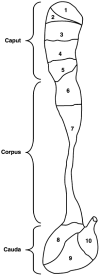Adaptive evolution of proteins secreted during sperm maturation: an analysis of the mouse epididymal transcriptome
- PMID: 18056076
- PMCID: PMC2915769
- DOI: 10.1093/molbev/msm265
Adaptive evolution of proteins secreted during sperm maturation: an analysis of the mouse epididymal transcriptome
Abstract
A common pattern observed in molecular evolution is that reproductive genes tend to evolve rapidly. However, most previous studies documenting this rapid evolution are based on genes expressed in just a few male reproductive organs. In mammals, sperm become motile and capable of fertilization only after leaving the testis, during their transit through the epididymis. Thus, genes expressed in the epididymis are expected to play important roles in male fertility. Here, we performed evolutionary genetic analyses on the epididymal transcriptome of mice. Overall, epididymis-expressed genes showed evidence of strong evolutionary constraint, a finding that contrasts with most previous analyses of genes expressed in other male reproductive organs. However, a subset of epididymis-specialized, secreted genes showed several signatures of adaptive evolution, including an increased rate of nonsynonymous evolution. Furthermore, this subset of genes was overrepresented on the X chromosome. Immunity and protein modification functions were significantly overrepresented among epididymis-specialized, secreted genes. These analyses identified a group of genes likely to be important in male reproductive success.
Figures





Similar articles
-
Sperm acquire epididymis-derived proteins through epididymosomes.Hum Reprod. 2022 Apr 1;37(4):651-668. doi: 10.1093/humrep/deac015. Hum Reprod. 2022. PMID: 35137089 Free PMC article.
-
Junctional adhesion molecule A: expression in the murine epididymal tract and accessory organs and acquisition by maturing sperm.Mol Hum Reprod. 2017 Feb 10;23(2):132-140. doi: 10.1093/molehr/gaw082. Mol Hum Reprod. 2017. PMID: 28062807 Free PMC article.
-
Transcriptome analysis of the epididymis from Plag1 deficient mice suggests dysregulation of sperm maturation and extracellular matrix genes.Dev Dyn. 2020 Dec;249(12):1500-1513. doi: 10.1002/dvdy.254. Epub 2020 Oct 6. Dev Dyn. 2020. PMID: 32959928
-
[Specialized gene expression and regulation in the epididymis].Zhonghua Nan Ke Xue. 2006 Jan;12(1):71-4. Zhonghua Nan Ke Xue. 2006. PMID: 16483167 Review. Chinese.
-
The Role of the Epididymis and the Contribution of Epididymosomes to Mammalian Reproduction.Int J Mol Sci. 2020 Jul 29;21(15):5377. doi: 10.3390/ijms21155377. Int J Mol Sci. 2020. PMID: 32751076 Free PMC article. Review.
Cited by
-
Molecular Evolution of Ecological Specialisation: Genomic Insights from the Diversification of Murine Rodents.Genome Biol Evol. 2021 Jul 6;13(7):evab103. doi: 10.1093/gbe/evab103. Genome Biol Evol. 2021. PMID: 33988699 Free PMC article.
-
Sperm proteomics reveals intensified selection on mouse sperm membrane and acrosome genes.Mol Biol Evol. 2010 Jun;27(6):1235-46. doi: 10.1093/molbev/msq007. Epub 2010 Jan 15. Mol Biol Evol. 2010. PMID: 20080865 Free PMC article.
-
Extraordinary sequence divergence at Tsga8, an X-linked gene involved in mouse spermiogenesis.Mol Biol Evol. 2011 May;28(5):1675-86. doi: 10.1093/molbev/msq348. Epub 2010 Dec 24. Mol Biol Evol. 2011. PMID: 21186189 Free PMC article.
-
Adaptation and constraint at Toll-like receptors in primates.Mol Biol Evol. 2010 Sep;27(9):2172-86. doi: 10.1093/molbev/msq104. Epub 2010 Apr 21. Mol Biol Evol. 2010. PMID: 20410160 Free PMC article.
-
Genome-wide architecture of reproductive isolation in a naturally occurring hybrid zone between Mus musculus musculus and M. m. domesticus.Mol Ecol. 2012 Jun;21(12):3032-47. doi: 10.1111/j.1365-294X.2012.05583.x. Epub 2012 May 14. Mol Ecol. 2012. PMID: 22582810 Free PMC article.
References
-
- Anderson MJ, Hessel JK, Dixson AF. Primate mating systems and the evolution of immune response. J Reprod Immunol. 2004;61:31–38. - PubMed
-
- Andres JA, Maroja LS, Bogdanowicz SM, Swanson WJ, Harrison RG. Molecular evolution of seminal proteins in field crickets. Mol Biol Evol. 2006;23:1574–1584. - PubMed
-
- Bedford JM, Hoskins DD. The mammalian spermatozoon: morphology, biochemistry, and physiology. In: Lamming GE, editor. Marshall's physiology of reproduction. London: Churchill Livingstone; 1990. pp. 379–568.
Publication types
MeSH terms
Substances
Grants and funding
LinkOut - more resources
Full Text Sources
Other Literature Sources

